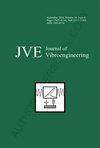基于运行传递路径分析技术的汽轮发电机振动源识别
IF 0.9
Q4 ENGINEERING, MECHANICAL
引用次数: 0
摘要
旋转机械中的不稳定振动可能源于各种原因,因此很难确定其来源。本研究介绍了运行传递路径分析方法(OTPA),作为识别汽轮发电机振动原因的一种方法。该模型以功率、电流等运行参数为输入,以振幅为输出,建立了震源分析模型。针对病态输入矩阵,采用奇异值分解方法。通过求解传递矩阵和分析参数贡献,确定了影响振动的主要因素。将该方法应用于660MW汽轮发电机组的振动源分析。发电机在一段时间内经历了未知原因的不稳定振动。运行传递路径分析表明,氢气压力、氢气温度和轴承温度对振动有显著影响。发电机转子中的热不平衡和轴错位被推断为可能的原因。通过调整氢气压力和温度,发电机振动得到控制,直到下一次大修。随后的维护显示氢气通风孔部分堵塞,导致转子热不平衡。证实了该方法的可行性。本研究的目的是提出一个有效的数据驱动模型,用于识别众多变量中的主要影响参数。该模型可应用于发电机组的智能故障诊断。本文章由计算机程序翻译,如有差异,请以英文原文为准。
Turbo generator vibration source identification based on operational transfer path analysis technology
Unstable vibrations in rotating machinery can stem from various causes, making it challenging to determine their origins. This research introduces the operational transfer path analysis method (OTPA) as a means to identify the causes of turbo generator vibrations. The model takes operational parameters, such as power and current, as input, and the vibration amplitude as output, to establish the source analysis model. To address the ill-conditioned input matrix, the singular value decomposition method is employed. By solving the transmissibility matrix and analyzing parameter contributions, the primary factors influencing vibration are identified. This method is applied to analyze the vibration sources in a 660 MW turbine generator unit. The generator experienced unstable vibration of unknown origin for a certain period. Operational transfer path analysis revealed that hydrogen pressure, hydrogen temperature, and bearing temperature significantly impacted the vibrations. Thermal imbalances and shaft misalignment in the generator rotor were inferred as the likely causes. Through adjustments to hydrogen pressure and temperature, the generator vibration was controlled until the next overhaul. Subsequent maintenance revealed partial blockage of the hydrogen ventilation holes, leading to rotor thermal imbalances. The feasibility of this method was confirmed. The objective of this study is to present an effective data-driven model for identifying the main influential parameters among numerous variables. This model can be applied to intelligent fault diagnosis in power generation units.
求助全文
通过发布文献求助,成功后即可免费获取论文全文。
去求助
来源期刊

Journal of Vibroengineering
工程技术-工程:机械
CiteScore
1.70
自引率
0.00%
发文量
97
审稿时长
4.5 months
期刊介绍:
Journal of VIBROENGINEERING (JVE) ISSN 1392-8716 is a prestigious peer reviewed International Journal specializing in theoretical and practical aspects of Vibration Engineering. It is indexed in ESCI and other major databases. Published every 1.5 months (8 times yearly), the journal attracts attention from the International Engineering Community.
 求助内容:
求助内容: 应助结果提醒方式:
应助结果提醒方式:


